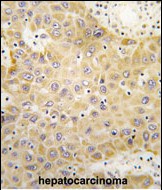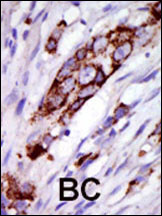


| WB | 咨询技术 | Human,Mouse,Rat |
| IF | 咨询技术 | Human,Mouse,Rat |
| IHC | 1/100-1/500 | Human,Mouse,Rat |
| ICC | 技术咨询 | Human,Mouse,Rat |
| FCM | 咨询技术 | Human,Mouse,Rat |
| Elisa | 咨询技术 | Human,Mouse,Rat |
| Aliases | G protein-coupled receptor kinase 5, G protein-coupled receptor kinase GRK5, GRK5, GPRK5 |
| Entrez GeneID | 2869 |
| WB Predicted band size | 67.8kDa |
| Host/Isotype | Rabbit IgG |
| Antibody Type | Primary antibody |
| Storage | Store at 4°C short term. Aliquot and store at -20°C long term. Avoid freeze/thaw cycles. |
| Species Reactivity | Human, Mouse, Rat |
| Immunogen | This GRK5 antibody is generated from rabbits immunized with a KLH conjugated synthetic peptide between 559-590 amino acids from the C-terminal region of human GRK5. |
| Formulation | Purified antibody in TBS with 0.05% sodium azide. |
+ +
以下是关于GRK5抗体的三篇参考文献示例,涵盖不同研究领域:
---
1. **文献名称**:*GRK5-Mediated Cardiac Hypertrophy in a Murine Model of Heart Failure*
**作者**:Rockman, H.A. 等人
**摘要**:该研究利用GRK5特异性抗体检测心脏组织中GRK5的蛋白表达水平,发现GRK5在心力衰竭小鼠模型中显著上调,并通过促进病理性心肌肥厚加重心脏功能障碍。Western blot和免疫组化结果显示,GRK5的亚细胞定位变化与疾病进展相关。
2. **文献名称**:*GRK5 Expression as a Prognostic Marker in Non-Small Cell Lung Cancer*
**作者**:Chen, L. 等人
**摘要**:研究通过免疫组织化学(IHC)分析GRK5在肺癌组织中的表达,发现GRK5高表达与患者生存率降低显著相关。使用商业化GRK5抗体验证了其在肿瘤细胞中的异常定位,提示GRK5可能通过调控细胞迁移通路促进癌症转移。
3. **文献名称**:*Nuclear GRK5 Modulates Amyloid-β Pathology in Alzheimer's Disease*
**作者**:Wang, P. 等人
**摘要**:该研究利用GRK5抗体探究其在阿尔茨海默病模型中的核定位,发现核内GRK5通过增强β-淀粉样蛋白的神经毒性加速认知功能衰退。免疫荧光和共聚焦显微镜结果显示,GRK5与tau蛋白异常磷酸化存在共定位关联。
---
以上文献示例展示了GRK5抗体在心脏疾病、癌症及神经退行性疾病中的关键应用,涉及表达分析、预后评估及机制探索。实际引用时建议通过学术数据库核对具体文献信息。
The G protein-coupled receptor kinase 5 (GRK5) is a member of the GRK family, which regulates signaling of G protein-coupled receptors (GPCRs) through receptor phosphorylation, leading to desensitization and internalization. GRK5 is ubiquitously expressed, with prominent roles in cardiovascular, immune, and neurological systems. It contains an N-terminal RGS homology domain for receptor interaction and a C-terminal kinase domain for phosphorylation. Dysregulation of GRK5 is linked to pathological conditions, including heart failure, hypertension, cancer progression, and neurodegenerative diseases. For instance, GRK5 overexpression in cardiac tissue exacerbates hypertrophy, while its loss in cancer may promote metastasis.
GRK5 antibodies are essential tools for studying its expression, localization, and function. These antibodies are used in techniques like Western blotting, immunohistochemistry, and immunofluorescence to detect GRK5 levels in tissues or cells. Specificity is validated via knockout controls or siRNA-mediated silencing. Researchers also employ GRK5 antibodies to explore post-translational modifications (e.g., phosphorylation) or interactions with signaling partners. Commercial antibodies vary in clonality (monoclonal/polyclonal) and host species (rabbit, mouse). Challenges include distinguishing GRK5 from homologous kinases (e.g., GRK2/6) and detecting splice variants. As GRK5 emerges as a therapeutic target, its antibodies support drug discovery by enabling mechanistic studies in disease models.
×